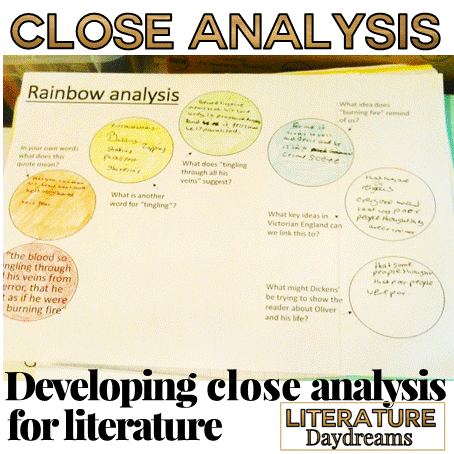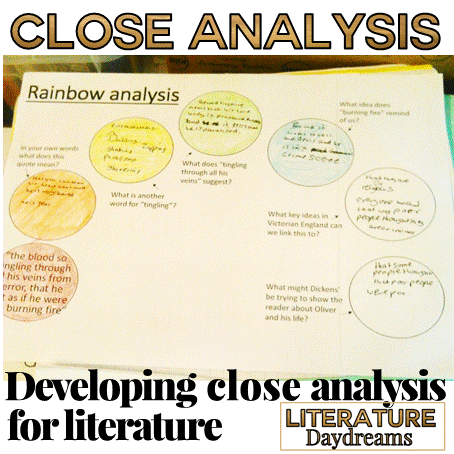1 secret for developing close analysis skills

Developing close analysis skills when teaching literature texts can be tricky. Think of all the things a student needs to know first:
- vocabulary knowledge
- understanding of explicit and implicit meanings
- working out which implicit meanings are relevant or useful
- ability to recognise figurative language and appreciate what is suggested
- how layers of meaning are created and how to work them out
Developing an understanding of explicit and implicit meaning
Here’s what we talk through first – explicit and implicit information. I introduce this very simply. Explicit information is clearly written in the text. “Last weekend, it rained a lot.” The text states it rained, so we know it rained. Implicit information needs a little detective work – we use our existing knowledge of the world around us to work out what is being suggested.
We look at the above example. The explicit information is that two people (named Mark and Clara) paid for some tickets for ‘something’ and after that they went to buy some popcorn. We use our existing knowledge of the world to workout that Mark and Clara at the cinema. They could be at a show, the theatre, or at a gig, but we suspect not. And I ask students to explain why not.
Here’s what they generally come up with: most people who go out, go to the cinema (after all tickets for shows, theatre and gigs are expense). If you are going to a gig, you won’t be buying popcorn. This is also probably true for theatres and shows – we leave this for the interval.
After working through this inference together – students try the following:
- Yesterday we packed everything into boxes and drove to another town.
- Paul had a bad night’s sleep and then when he woke up, there were branches and leaves all over the roads.
- It was always Sally’s dream to have a puppy, yesterday that dream came too.
This week I have also been using this amazing trailer from Miss Peregine’s Home for Peculiar Children. There is so much that is hinted at this trailer – it’s great to discuss.
So now we develop our inference skills into analysis skills!
Rainbow Analysis
I first came across the idea of Rainbow Analysis on Twitter about a year ago. You can see the details here.
It is a structured and visual way to ensure that students are creating detailed inferences and then turning this into close analysis. As you can see the sheet has 7 circles in an arc shape. You can pretty much use these circles for any purpose that suits your outcome.
Here is what I include:
Circle 1: quotation
Circle 2: what does the quote mean in your own words?
Circle 3: choose one word (or short phrase) from the quotation and identify the technique used by the author (eg simile)
Circle 4: Now zoom in on the implied meaning of the word or phrase and explain what is suggested by it.
Circle 5: Are there alternative interpretations that could be made of the quotation? Does it contain ambiguous language or ambiguity of meaning?
Circle 6: How does the quotation link to contextual factors such as the period in history or the author’s biographical context?
Circle 7: How does the quotation challenge or impact the reader’s thinking about the character or situation?
Of course, then we colour it all in – to remind ourselves that we are understanding the shades of meaning. Soooo, friends, would you like to give it a go? Well, signup to my newsletter below and you can download the resources from my FREE resource library.
If you are interested in seeing some of my literature resources in action, find me on Facebook and Instagram. Check out my TpT store and sign up for my newsletter for exclusive material and tips and tricks!




